Notions of photographic truth and memory are both inherent and veiled in these expressionistic images. Chiara recently wrote on this subject,“Photography has a long and complicated relationship to memory and the madness of the self-encounter. I find that strong visual memories are produced because of their psychological connection to moments of intense self-reconciliation. As time passes, what was being reconciled becomes no longer attached, but the psychological weight burns the visual into memory. Visual memory seems to always be in flux. Memories are unbound, with divergent edges. You have to move around in them to get to points of clarity.”

Three images from the Starr King: Coral Beacon series, copyright and courtesy John Chiara.
With an exhibition of new work by Chiara opening Thursday at Von Lintel Gallery in Chelsea, I caught up with him last week for this email interview:
Peggy Roalf: What kind of pictures did you make when you first became seriously interested in photography?
John Chiara: I think I have always been seriously interested in photography. I was seduced by it at a very young age. I grew up sitting in a darkroom watching my father develop black-and-white prints under a red light. Watching the image come out of nowhere was magical to me, as a child. Since then I have used photography primarily as a method consisting of careful observation, pre-visualization and intuition. The pictures I have taken throughout my life have for the most part been of nothing in particular.
PR: When did the idea of personal vs. photographic truth vs. photo-historical memory become part of your ethos?
JC: In 1994 I graduated from college and moved back to the Bay Area. At this time I got a job at a lab. A sweat shop really. The one good thing about it was that the job was not very stimulating in any way. I was able to spend eight hours a day [at the lab] thinking over what I was reading, Mostly biographies of important writers and photographers. I also spent this time thinking about the photographs I was making, what photography is, ideas about photographic memory, etc. These things tend to seep into your work. This went on for years.
PR: Has living in the Bay Area influenced your approach to photography?
JC: In a way, yes. I definitely am influenced by what is right around me and the Bay Area has the right ingredients. I am able to find the images I want to make here. Also, over the years I have been able to carve out just enough space in San Francisco to develop my process.
PR: What were you working on when you realized that you needed a specific type of camera, one that you would build yourself, to get the kind of images you had in mind?
JC: Once I started contact printing my 2-1/4 negatives from my twin lens camera, I realized that I could never enlarge an image again. This was in 1994. I was working on a series of images that are strikingly similar to the images in the Fort at Lime Point series. I was photographing the same sculptures at Laney Junior College and paring them with photographs of barren slopes that resemble the Fort Barry Shooting Range photograph in the show.
Read full interview @ DART


No comments:
Post a Comment